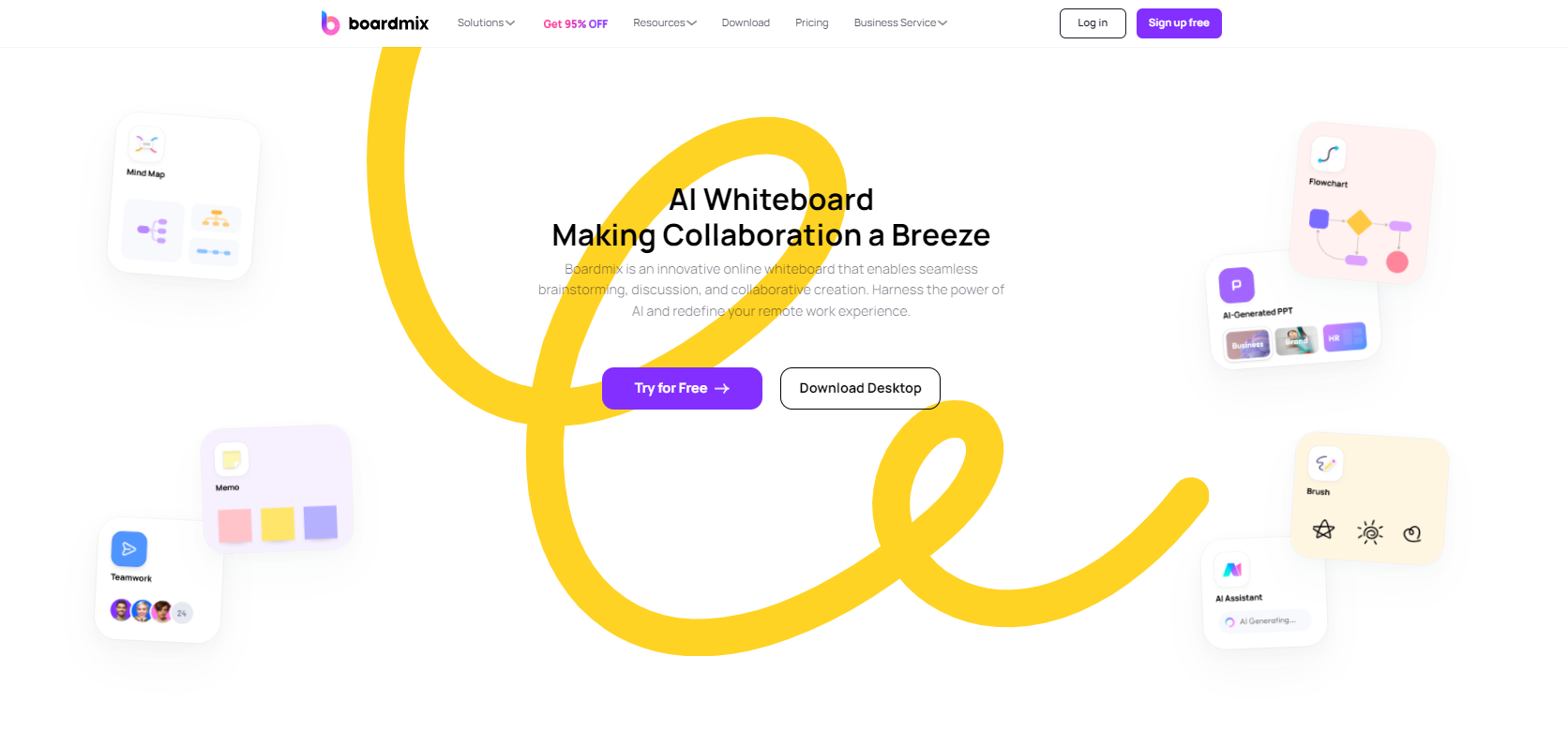A lean canvas is a strategic document that gives you enough space to brainstorm and formulate your entrepreneurial ideas. That’s why it’s a modeling tool that you should learn how to use, especially if you are thinking of launching your startup. In this article, we will explain the lean model canvas and show you 10 examples of famous brands, so that you get a deeper understanding of this invaluable tool. ⭐Hope that with this introduction you can create disirable lean canvas with with our effective online whiteboard Boardmix!
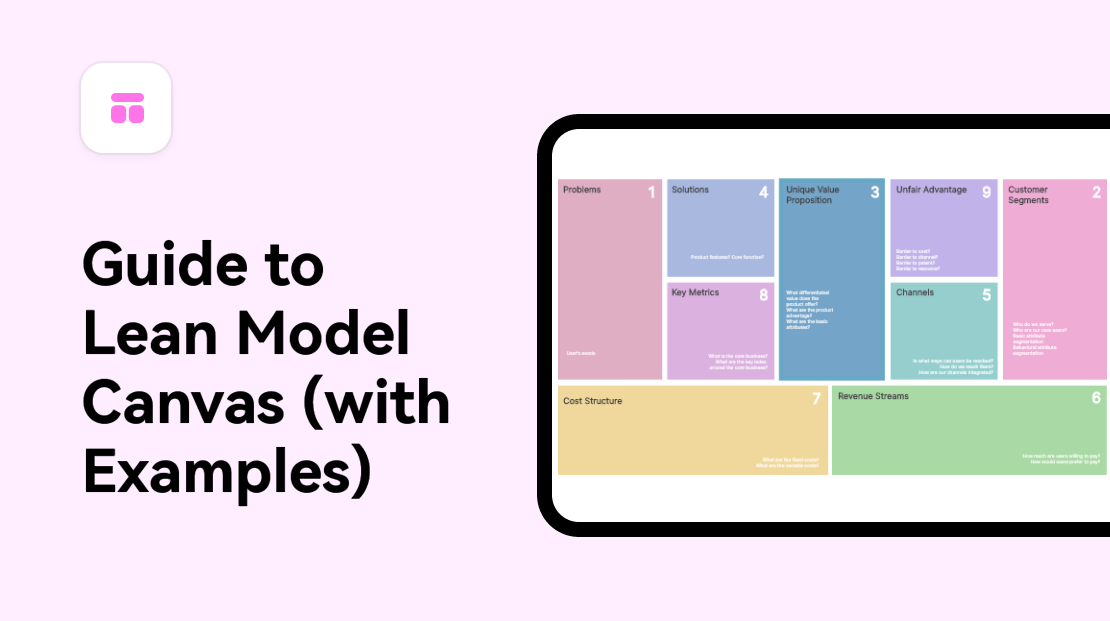
What Is Lean Canvas
The first to understand this tool is to define it before we start analyzing each lean canvas example. Generally, a lean model canvas is a type of strategic document that gathers all the elements of a business plan on a single page. The template is divided into nine separate sections that allow you to dissect your business idea with a problem-and-solution approach.
Taking a look at every lean canvas example, you will notice that this template consists of 9 blocks. All these components are placed in a logical order so that you can easily figure out the solution to each problem.In more detail, the components found in a lean model canvas are the following:
- Problem – your product and service should solve a specific problem. Therefore, in this section of the lean canvas example, you have to identify and write down your audience’s needs and the problems you will be trying to solve with your product.
- Customer Segments – the next section is about the customer segment, which will show you who your target audience is. This is a particularly important component since successful targeting will guarantee sales for your product.
- Unique Value Proposition – at the heart of your business there are the questions of what makes your product unique and why should customers pay for it. This is the element that justifies the launch of your product, and for this reason, this block takes a central position in the lean model canvas.
- Solution – in this block, you have to write down the possible solutions to the problems you have already identified. It consists of the functions that allow you to stay true to the promise you’ve made in the unique value proposition segment.
- Channels – this block of the lean canvas example contains all the methods that your product will reach your target audience. For instance, you might choose to reach out to them on social media, TV, blog posts, or any other way.
- Revenue Streams – having a great business idea is not enough. If you want your startup to be successful, you need to actually start making money. This section showcases all the ways that you can generate revenue.
- Cost Structure – this is an equally important block to the previous one. In this particular block, you must write down all the costs that your business endeavor includes, from creating your product to marketing.
- Key Metrics – the next component analyzes the key metrics of your business. These are the elements that allow you to evaluate the success of your startup.
- Unique Advantage – this section is about the unfair advantage that is unique to your business. In essence, it is what makes your startup stand out from the rest, and it’s something that no one can copy.
10 Lean Canvas Examples
Following are 10 examples of lean canvas for your startup. To make things easier, your first step is to create an account of Boardmix. This online collaboration whiteboard tool provides you with numerous readymade templates to create any type of diagram you need. In addition to this, Boardmix has just introduced an AI assistant that can not only collect data but also analyze them.
Lean Canvas Example of Apple

In Apple’s lean canvas example, we can see that the main problem is that computers were far from user-friendly. Thus, the user segment should be everyone using a computer, such as office workers and students. So, the solution and unique value proposition of the company is a portable computer with exceptional usability and modern design.
The channels they’ve chosen are advertising, direct communication with customers, and word of mouth. The revenue stream comes from direct sales, and the cost structure contains the production and marketing costs. The key metrics for Apple are the ROI and the number of loyal customers. Finally, the brand’s unfair advantage is its clear and concise strategy for future releases.
Lean Canvas Example of SpaceX
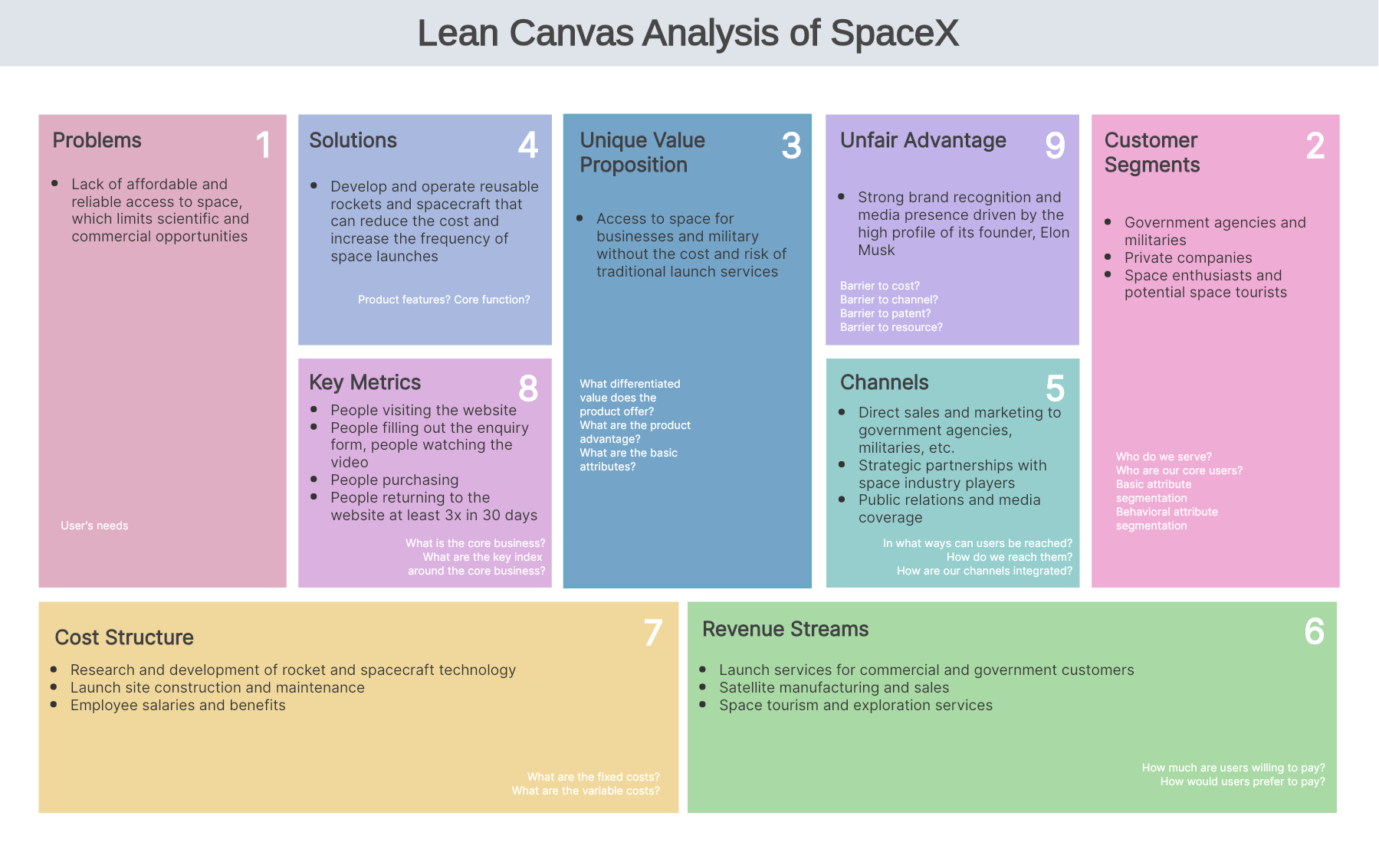
The lean model canvas of SpaceX states that the problem they try to solve is the lack of affordable access to space. Therefore, the customer segment consists of government organizations, the military, private companies, and space enthusiasts. The brand approaches these potential customers with the unique value proposition of getting to space without cost and risk since their solution is to develop reusable spacecraft parts.
The channels that SpaceX has selected are public relations, strategic partnerships, and direct sales. The brand’s revenue comes from the launch of services, the manufacturing of satellites, and space tourism. The cost structure includes research and development of new spacecraft technologies, manufacturing of the products, and marketing costs. The key metrics for SpaceX are their ROI and their website’s performance. Finally, the unfair advantage of this company is the strong brand recognition due to its founder, Elon Musk.
Lean Canvas Example of Tesla

Tesla’s lean canvas example shows you that the main problem is the promotion of eco-friendly cars to more people. Thus, they are targeting eco-conscious drivers and sports car lovers. The brand’s unique value proposition and solution is electric cars with efficient performance.
The channels that Tesla is using are advertising, interaction with buyers, retail stores, and word of mouth. Their revenue comes from direct sales and venture capital, and their cost structure consists of car production and advertising. Tesla’s unfair advantage is Roadster, which is the most recognizable electric car.
Lean Canvas Example of Uber
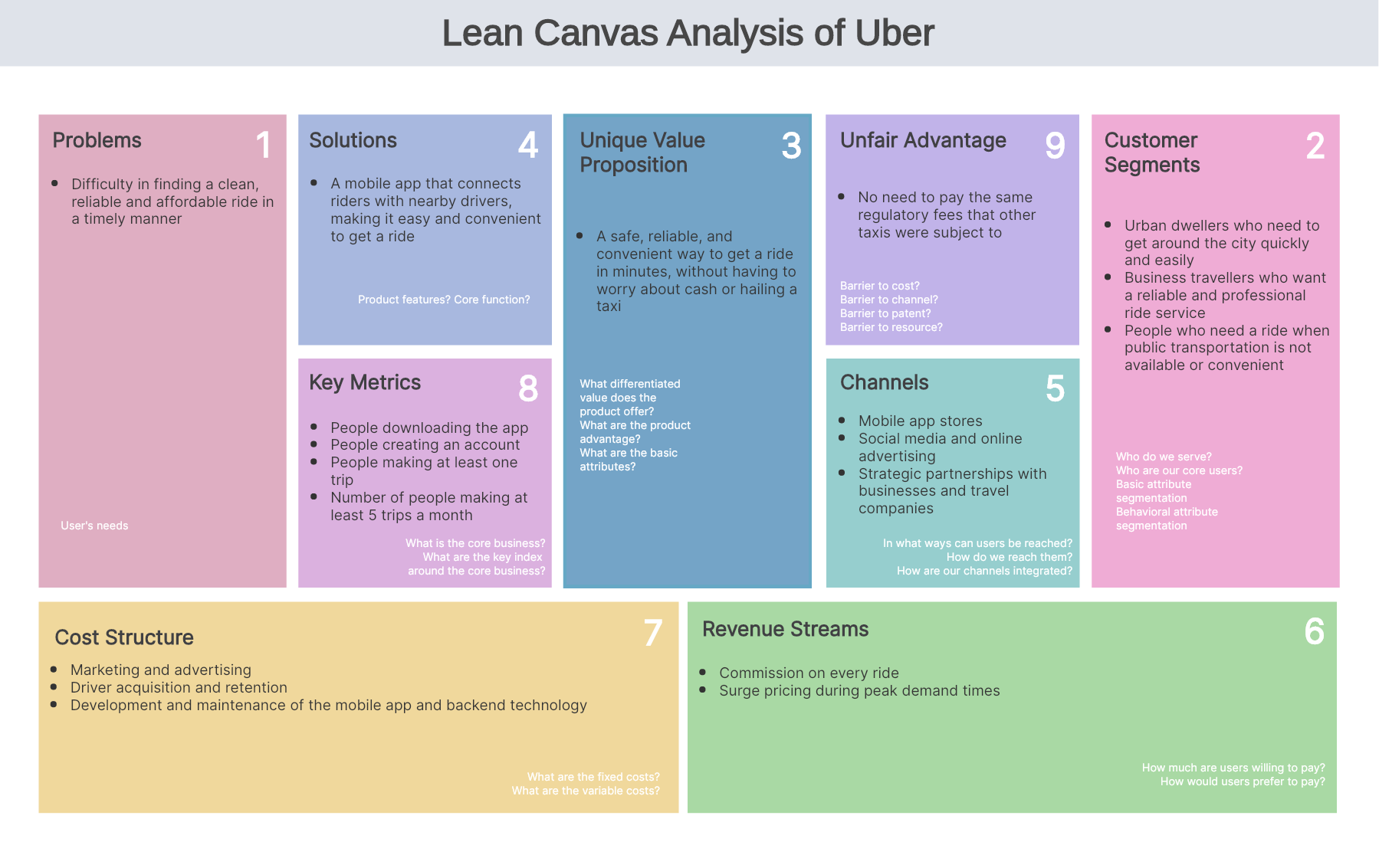
Uber’s lean model canvas example states that the main problem is to find a clean and affordable ride whenever you need it. The brand targets people that live in urban areas, business travelers, and everyone inconvenienced by public transportation. The unique value proposition is to always find a reliable ride within minutes, without worrying about having cash. This leads to the solution of launching an app that connects passengers and drivers.
The channels that Uber has chosen are app stores and social media, as well as strategic partnerships. The revenue stream of the company consists of commissions from every ride and surge pricing, while the cost structure contains the app’s maintenance, the driver acquisition and retention, and the marketing. The key metrics for Uber are how many users download the app, activate their account, and keep on using it. Lastly, the brand’s unfair advantage is that it doesn’t have the same regulatory fees as taxis.
Lean Canvas Example of Airbnb

Airbnb has an interesting lean canvas example since the problems it solves concern the difficulty of finding nice lodging when traveling and the difficulty of finding guests as a homeowner. Therefore, it targets both travelers and hosts by providing them with their unique value proposition, which is an authentic experience and extra monetization for their empty spaces. The solution to this is an online platform that connects the two user segments.
The channels that Airbnb has selected are marketing campaigns, referrals, and recommendations. The company’s revenue comes from commissions from every booking, and their costs consist of marketing and the platform’s hosting and maintenance. The key metrics include the number of bookings and hosts applying for the service. Lastly, the unfair advantage of Airbnb is that everyone could potentially participate and make money from renting their space.
Lean Canvas Example of Amazon
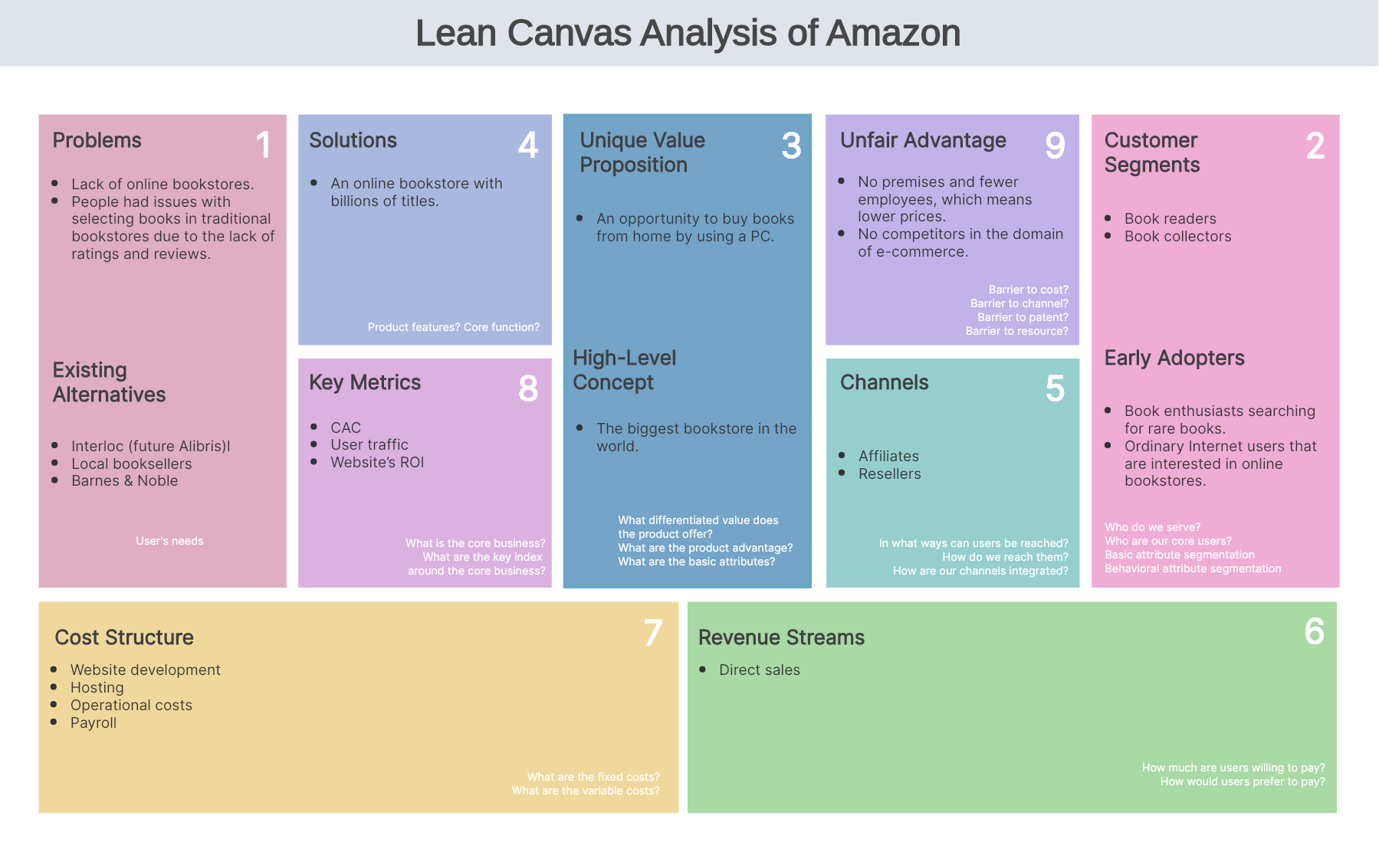
Amazon’s lean model canvas example refers to the time of its launch back in 1994. Then, the main problem was a lack of online bookstores and readily available book ratings. Therefore, the company introduced the unique value proposition of purchasing books online through an online bookshop with millions of available titles.
The channels that we see on the template are affiliates and resellers of books. Amazon’s stream comes from direct sales, while its costs contain the website’s development, hosting, and maintenance. The key metrics are the customer acquisition cost and the ROI. Finally, Amazon’s unfair advantage is that it doesn’t have any premises or employees, which lowers the products’ prices.
Lean Canvas Example of Google
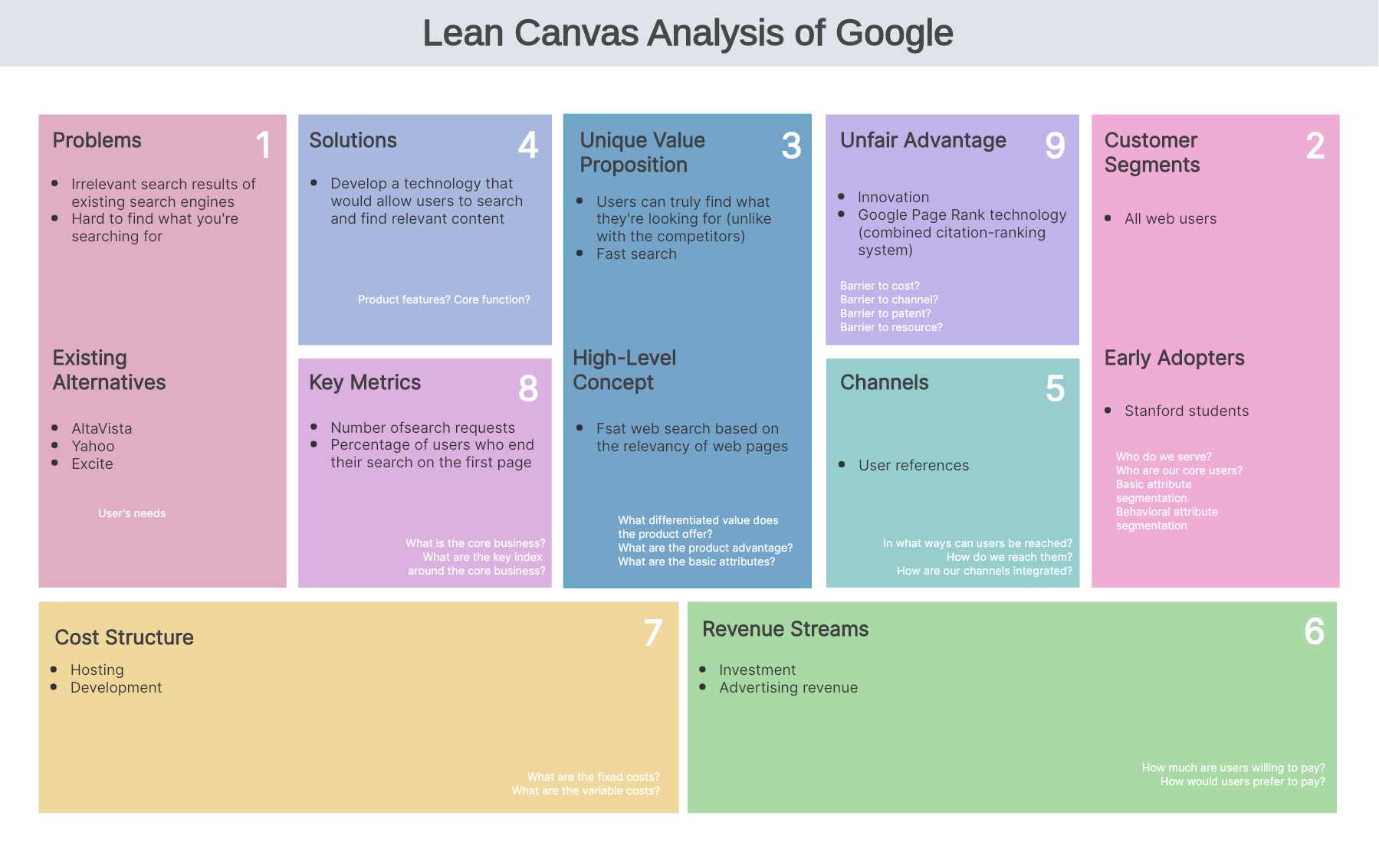
The following lean canvas example shows that Google’s main problem is the irrelevant Internet search results. Therefore, the unique value it offered to all web users was a new technology that would allow them to search quickly for whatever they needed to.
It’s interesting to see that the only channel Google is using is user references. The company’s revenue comes from investments and advertising, while its costs consist of the tool’s development and hosting. The key metrics are the number of search queries and how many results each user is browsing. The unfair advantage of Google is the innovation it brought.
Lean Canvas Example of YouTube
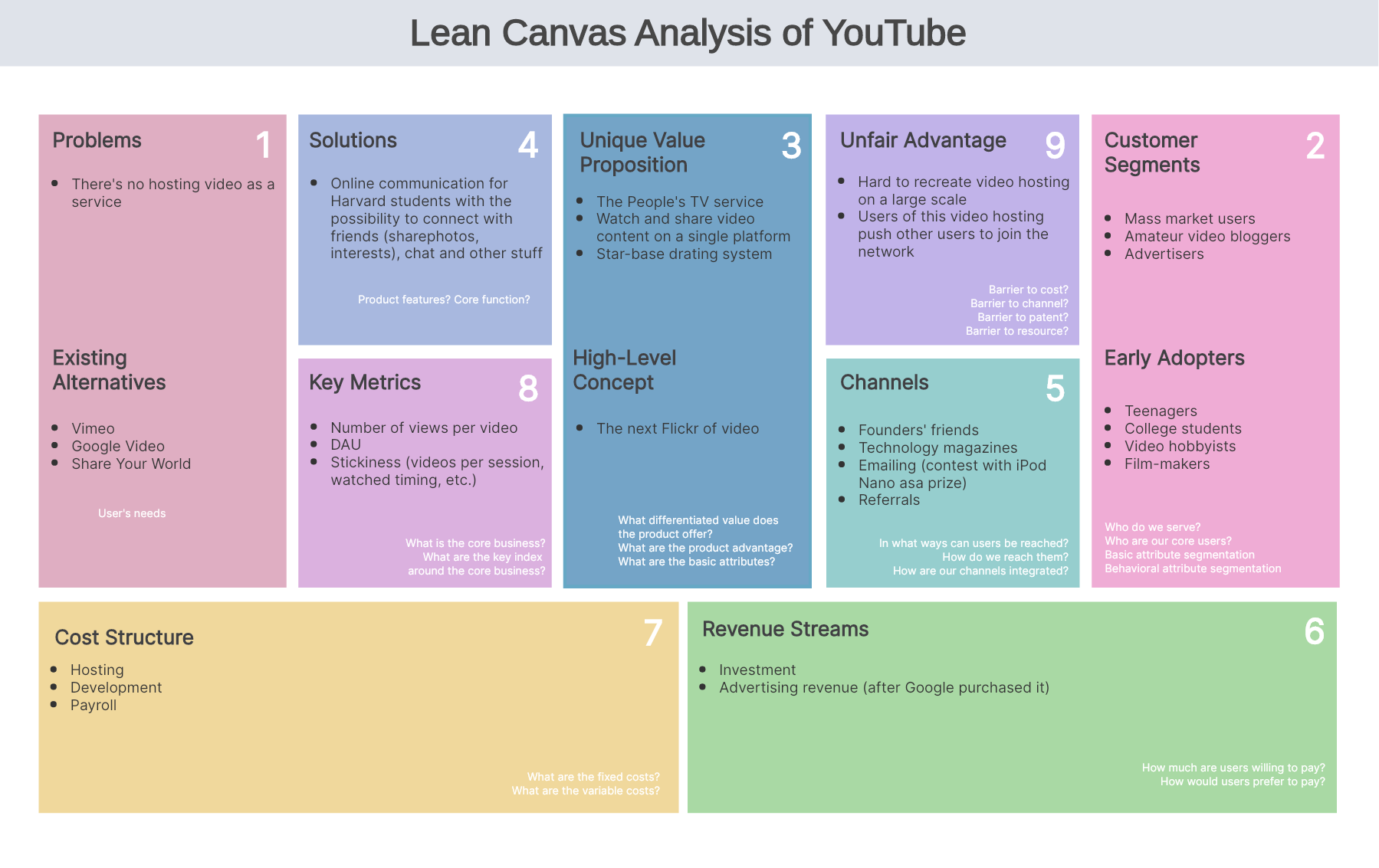
YouTube recognized that there wasn’t a hosting video service, as you can see from their lean model canvas. Therefore, its unique value proposition was that everyone could upload, find, share, and rate videos through a dedicated website.
The channels that YouTube selected for their business were referrals, email marketing, technology magazines, and personal connections. The revenue stream contains investment and advertising and the cost structure includes the platform’s development, hosting, and maintenance. YouTube’s unfair advantage was the difficulty of recreating a platform such as this one.
Lean Canvas Example of Facebook

Facebook’s lean canvas example focuses on the students’ problem that there wasn’t a fun and functional university platform to communicate. Therefore, it proposed a university-wide online platform with multiple functions, such as chat and photo sharing.
The channels that the company used were referrals and word of mouth. As happens with many online platforms, Facebook’s revenue comes from investments and advertising, and the costs consist of the platform’s development, hosting, and maintenance. All in all, Facebook’s unfair advantage was that it introduced a new type of website that focused on personal interactions.
Lean Canvas Example of Bike Sharing
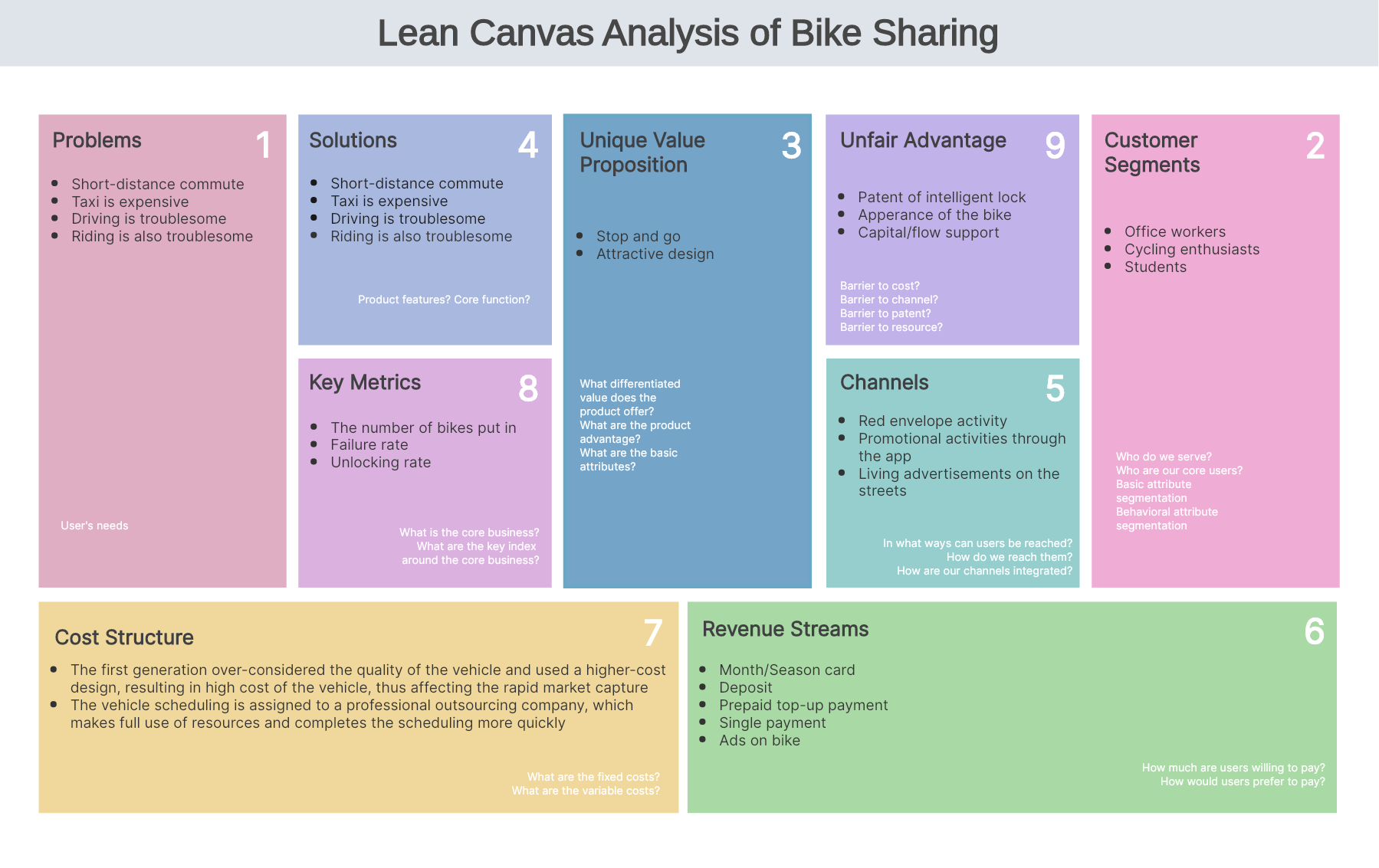
The bike-sharing company’s lean model canvas focuses on the fact that driving and riding are troublesome and that taxis are expensive, especially for short-distance commuting. Office workers, students, and cycling enthusiasts will take advantage of the company’s stop-and-go approach. The solution that the brand proposes is a mobile app that controls remotely the bike and has an intelligent lock.
The channels that the brand has chosen are various promotional activities through the app and discount activities. The revenues come from monthly or seasonal cards, prepaid payments, or one-time purchases, while the costs consist of the app’s development maintenance, and marketing. The key metrics for this business are the number of bikes, the unlocking rate, and the failure rate. Finally, the company’s unfair advantage is the innovative intelligent lock.
How to Create a Lean Canvas
Now you’ve seen enough examples to know what you need to do to create a lean canvas for your startup. Certainly, your initial action should be to set up an account with Boardmix. This digital cooperative brainstorming platform equips you with an array of pre-designed templates for constructing any diagram required. Moreover, AI assistant of Boardmix can facilitate gathering data but also scrutinizing it. As a result, you can formulate knowledgeable decisions when developing your diagrams.
Here is how to create a lean canvas with Boardmix:
Once in the Boardmix workspace, click New from template. Find and select the lean canvas template.
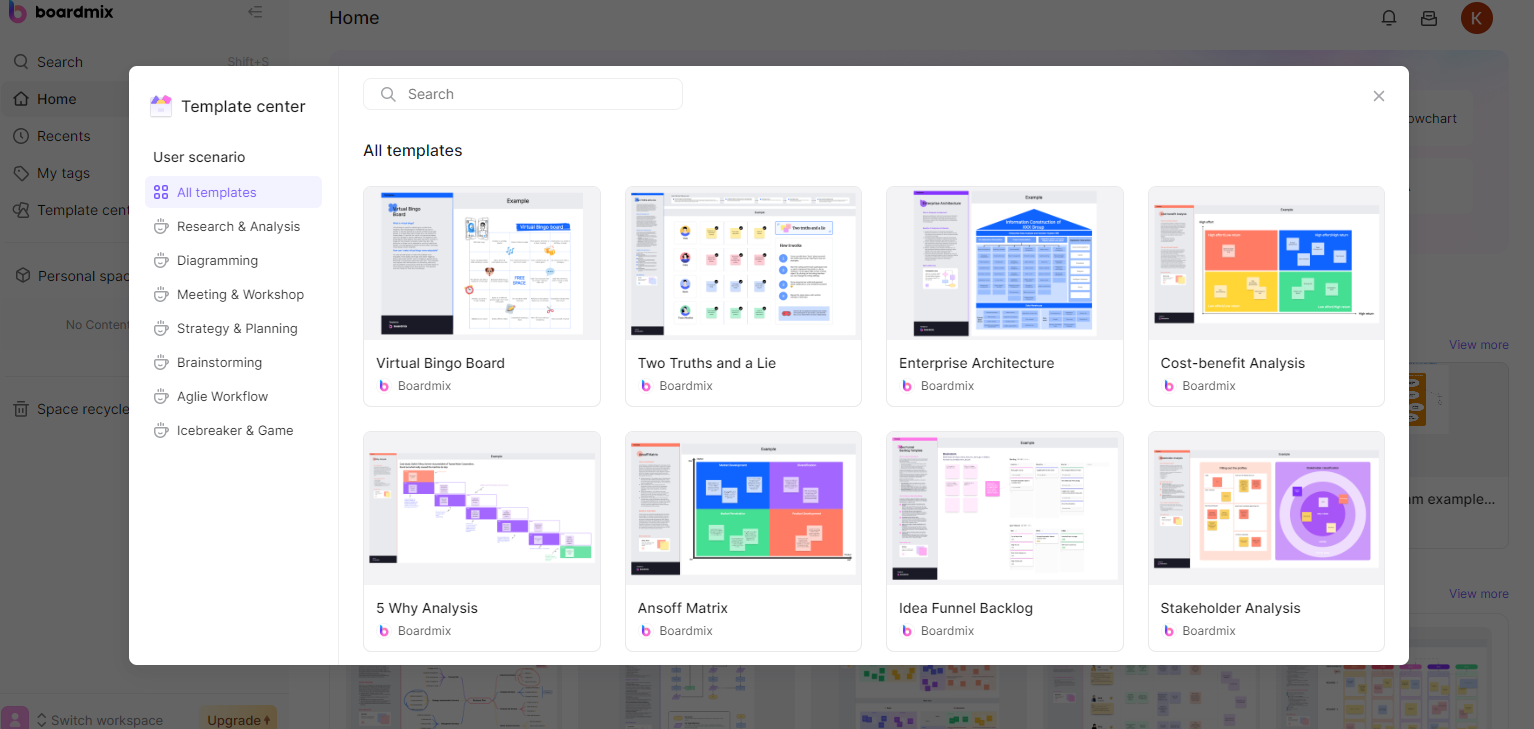
Find the appropriate sections and fill them out. To find the answers to each section, you must consider several questions:

- Problems – what do the users need?
- Customer segment – who are your core customers? Who is your target audience?
- Unique value proposition – What’s the value of your product? How is it different?
- Solution – what are the product’s main functions? What are some of its features?
- Channels – how will you reach your target audience? How are the channels integrated?
- Revenue stream – how will you generate profit? How much are customers willing to pay?
- Cost structure – what are the fixed costs? What are the variable costs?
- Key metrics – how will you evaluate your business’s success?
- Unfair advantage – what’s your unfair advantage (i.e. cost, channel, patent, resource)?
Once you have filled in all the relevant data, you can click the Share button to send your lean canvas to your collaborators.

Lean Canvas Vs Business Model Canvas
Similarities
In reality, a lean model canvas shares many similarities to the traditional business model canvas. The main similarities can be summarized as:
- Both tools consist of 9 building blocks that allow you to go through every aspect of your business.
- Both diagrams are 1-page documents that make it easy to share and revise.
- The components that are found in both diagrams are customer segments, channels, revenue streams, and cost structure.
Differences
Nevertheless, the lean canvas optimizes the process and deconstructs the lengthy business plan to help every aspiring entrepreneur spot the key elements of their ideas. Therefore, there are also many differences between lean canvas and business model canvas. The main differences between these tools are the following:
- Key partners become problems, key activities become solutions, key resources become key metrics, and customer relationships become an unfair advantage in the lean canvas.
- The lean canvas focuses more on solving particular problems, while the business model analyzes the strengths and weaknesses of the business.
- The lean canvas emphasizes the unfair advantage, a crucial element for a startup.
Wrapping Up
As you can see, the lean canvas is an invaluable tool for your tool. Right now, you can start creating it by taking advantage of Boardmix’s ready-made templates and AI assistant. Study all of the examples we have shown you here to get inspiration! 👉Come and creat your own lean canvas now!









